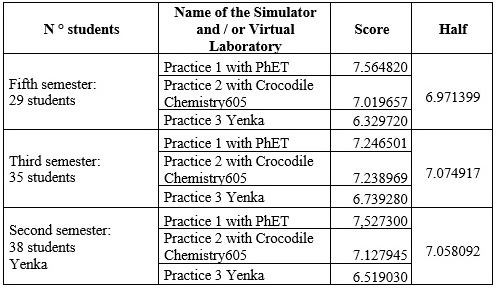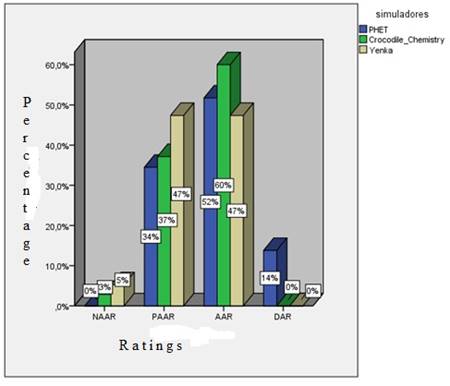INTRODUCTION
Learning Experimental Sciences, and especially Chemistry, imply “a set of systematic transformations in individuals after a series of experimental activities to link theory with practice, the stages of which occur in ascending order” (Hernández & Benítez 2018:8), being a progressive, dynamic, and transformative process that generates successive and uninterrupted changes in the student's cognitive activity.
Generally, experimental activities are educational actions, that promote experiences in a certain context, which are carried out by the student and / or the teacher in a cooperative manner; using materials, laboratory reagents and materials from their environment aimed at articulating theory and practice in the teaching-learning process, where the verification of its theoretical foundations, the observation and interpretation of chemical principles, are vital for the logical and interpretive reasoning of this science.
. (Urquizo & Varguillas 2020:67)The implementation of experimentation practices have contributed to deepening knowledge by identifying various study options, causing the students of the National University of Chimborazo to strengthen their skills through a motivational process, generated by meaningful, individual and learning strategies of social interaction, which allows the reconstruction of scientific phenomena, which comes from the practical process that determines integral learning in the classroom and in the laboratory
Nevertheless, due to the global confinement caused by the COVID-19 pandemic, all levels of education in the world adopted the virtual modality, and given the impossibility of going to the laboratory, the Chemistry teaching-learning process had to take relevant turns around the use of digital resources in order to promote a cognitive structure in students. Teachers were forced to develop new teaching strategies “based on ubiquitous, instantaneous, and sustained communication and collaboration in real time, which was unthinkable in ancient times” (Crespo & Palaguachi 2020:295).
. (Camacho 2018:23)Before the pandemic, the use of Information and Communication Technologies (ICT) in academic processes showed serious shortcomings due to the scarce use of technological resources, according to the needs of generation Z students, who use digital environments to communicate , has had to break the paradigm of traditional 1.0 education to make the qualitative leap to constructivist education 2.0 until reaching education 3.0 or connectivist, which is the digital age that allows facing the challenges of modern educational society
ICTs therefore contribute to a new understanding and vision of contemporary Education incorporating these technologies into new ways of conceiving teaching and learning. The National University of Chimborazo, especially the Career of Pedagogy of Experimental Sciences, Chemistry and Biology, in the face of world problems, sought new learning environments proposing the use of simulators and virtual laboratories in the educational teaching process to strengthen the pedagogical action of the teacher in the area of Chemistry and apply new teaching methods that allow meeting the proposed objectives despite the limitations of the COVID-19 pandemic.
On the web, there is a great variety of digital resources, being the selection of simulators and appropriate virtual laboratories, that illustrate concepts and principles that facilitate the understanding of students, “where manipulation, interaction with people build knowledge, activate their cognitive schemes through the process of assimilation and accommodation; where successive accommodation experiences give rise to novel assimilation schemes, thereby reaching a new state of equilibrium” (Raynaudo & Peralta 2017:142). All this aimed at developing a dynamic, progressive and transformative process for the meaningful learning of Chemistry.
LEARNING WITH THE USE OF SIMULATORS AND VIRTUAL LABORATORIES
Laboratory practice constitutes a powerful pedagogical strategy for the construction of conceptual, procedural, and even attitudinal competencies. In times of pandemic, the tools available on the web such as simulators and virtual laboratories with their theoretical models have been considered as computer tools that allow the development of numerical calculations and generate visual representations of different phenomena or situations that ICTs provide and simulate laboratories of chemical testing from a virtual environment.
Of course, they are limited in the teaching of certain aspects related to the “
” (Torres 2017:9).experimental practice of chemistry, but at the same time they have virtues that offer more plasticity than a real laboratory in the teaching of this science
Virtual Laboratories are also defined as experiential learning spaces that simulate conditions close to reality since they allow developing “laboratory practices through a menu located on the toolbar, such as a text editor, where equipment is available according to the needs of the practices and instructions executed by the operator through a computer” (Acosta 2019:29).
The implementation of interactive simulations “
” (López 2020:2), “becoming catalysts that transform and modify current learning scenarios, promoting motivation and dynamizing the teaching-learning processes that are linked to the requirements of the knowledge society” (Flores & Garrido 2019:46).used in education are virtual environments that allow the visualization and exploration of phenomena, where students manipulate variables using different controls, and receive feedback on the effect of that manipulation immediately through an animation
. (Carrión, García & Erazo 2020:212)For the educational system to obtain successful results when implementing all kinds of technological tools, in particular virtual simulators, it is a fundamental task of teachers to appropriate and use these new strategies in the classroom, which help to promote cognitive development, interaction between students, and the predisposition for them to learn and optimize their learning through the advantages that the world of virtual simulation presents
The teaching-learning process of Chemistry is not easy, so it is necessary for teachers to apply a variety of teaching strategies, as well as the use of various didactic resources appropriate to any teaching modality, which allow achieving the planned learning results. The use of simulators in times of the pandemic caused by COVID-19, applying the methodology of the Three Pedagogical Moments, is presented as a “possible alternative for the experimental activity in Chemistry, which approaches the reality of the students and the appropriation of knowledge scientist in a critical and reflective way” (Delgado, Kiausowa & Escobar 2021:20).
METHODOLOGY
The research was developed at the National University of Chimborazo, Faculty of Human Education Sciences and Technology, in the Career the Pedagogy of Experimental Sciences, Chemistry and Biology. This work is part of the research project: Educational Technologies and their impact on the inter-learning of Experimental Sciences in times of pandemic (COVID-19) in educational institutions of the Riobamba canton.
The study population was 188 students enrolled in the period November 2020-April 2021; an intentional non-probabilistic sampling was applied and corresponds to the students enrolled in the second, third and fifth semester in the subject of General Chemistry, Inorganic Chemistry and Chemical Physics respectively and it is made up of 102 students.
The study was mainly quantitative in nature, with a correlational level. The investigation was carried out in two phases; the first phase consisted of an online survey designed to obtain an assessment of the students' perception in relation to the cognitive and procedural aspects of the execution of the experimental activities achieved with the application of the virtual simulator Phet, as well as the virtual laboratories Crocodile Chemistry605 and Yenka.
In a second phase, based on the qualifications obtained, it was determined which virtual simulator is more effective in the Chemistry teaching-learning process. In each phase, the consent and authorization of the students was counted on, so that the obtained information contributes to the development of this investigation.
As instruments for data collection, a questionnaire, laboratory reports, and tests received online were used. The questionnaire was applied through the Google Forms tool, made up of 10 selection questions using the Likert Scale with 5 levels (Totally agree, agree, indifferent, disagree and totally disagree) to the study population related to aspects cognitive and procedural acquired in the process.
The data analysis was carried out with the academic performance of the students once the virtual experimental practices had been applied in the PhET simulator and the Crocodile Chemistry605 and Yenka virtual laboratories, the rating scale is described in Table 1.
Likewise, the data obtained were subjected to a statistical analysis process with the IBM SPSS Statistics 20 software package, the free access software Python, Rstudio and the free statistical analysis package Statdisk. The method applied to obtain the results was the heuristic one that allows obtaining knowledge, both propositional and procedural; try an alternative and see if it works (Coello, Blanco & Reyes 2012).
This research assumes Ausubel's theory of meaningful learning, which allows reinforcing the importance of using virtual simulators in the teaching of Chemistry and guiding the teacher to develop a more efficient teaching process, “based on the student's interest, such as this theorist believes, the student does not learn by chance, but consciously during the teaching-learning process” (Delgado, Kiausowa & Escobar 2021:6).
The construction of the didactic sequence with the use of simulators helped to understand the teaching-learning processes that involve three pedagogical moments, and was based on the proposal of Muenchen and Delizoicov, who with the objective of facilitating the transposition of Paulo Freire's conception of problematic education indicates the paths of this methodology, “
” (Muenchen & Delizoicov 2014:620).structured in three pedagogical moments: initial problematic; Organization of knowledge, and Application of knowledge
Initial problematization: Real questions or situations are presented that the students know, witness and are involved in the topics, matters that are not limited to guiding questions, which require that the students only memorize and reproduce the knowledge. At this pedagogical moment, students are challenged to explain what they know about situations, so that the teacher can know what they think.
Knowledge organization: At this time, under the teacher's guidance, the scientific knowledge necessary to understand the issues and the initial problematization is studied. The teacher will use various activities and methodological instruments, such as exposition, formulation of questions, texts for discussions, extra-class work, and experiences, among others.
Knowledge application: Moment destined to systematically approach the knowledge incorporated by the student, to analyze and interpret both the initial situations that determined their study and others that, although not directly linked to the initial moment, can be understood by the same knowledge.
The understanding of natural phenomena articulated with each other and with technology “
” (Delizoicov, Angotti & Pernambuco 2011:69).gives the area of Natural Sciences an interdisciplinary perspective, since it encompasses biological, physical, chemical, social, cultural and technological knowledge
The PhET simulator and the virtual laboratories Crocodile Chemistry605 and Yenka were used as an alternative didactic resource to teach students to learn the chemistry topics described below: Second semester worked with the topics of Physical properties of substances based on the type of chemical bonds and obtaining binary and ternary compounds.
With the third semester, chemical reactions for the formation of salts and limiting and excess reagent. With the fifth semester, were reviewed the properties of gases and their laws (Boyle, Charles and Gay Lussac). The link below contains the experimental activities that used the methodology described above: https://unachedu-my.sharepoint.com/:f:/g/personal/eurquizo_unach_edu_ec/EkG4CQTCj41CjSVJParT55YBlbyb-4qLPc3A8TsMoyfyfg?e=bSlyvx where you can see the process developed in each virtual experimental work guide.
RESULTS AND DISCUSSION
To measure the degree of acceptance of the planned experimental activities using the aforementioned virtual simulator and laboratory, an online questionnaire was applied using the Google Forms tool, the results of which were subjected to a statistical analysis process with the IBM SPSS Statistics 20 software package as shown in Table 2.
Table 2: Cognitive and procedural indicators
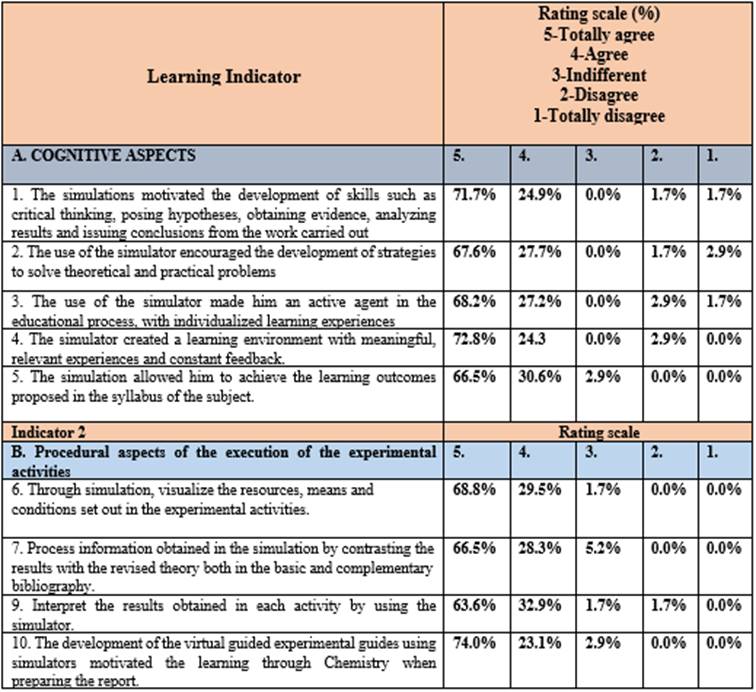
Source: Own elaboration from the collected data of the survey
As can be seen in Table 2, the survey was carried out based on both conceptual and procedural indicators. Regarding the conceptual indicator, 71.75% of the students fully agree that the use of simulators motivated the development of their skills, 67.6% encouraged the development of strategies to solve theoretical and practical problems, 68.2% became an active agent in the educational process, with individualized learning experiences, and 72.8% fostered a learning environment with meaningful, relevant experiences and constant feedback. Finally, 66.5% totally agree that the use of simulators allowed to achieve the learning results proposed in the syllabus of the subject.
According to the procedural indicator, 68.8% of total agree that through the simulation, the resources, means and conditions raised in the experimental activities are visualized. The 66.5% of the respondents process the information obtained in the simulation, contrasting the results with the theory. The 63.6% interpret the results obtained in each activity. Likewise, 74% of the students interpret the results obtained in each activity using the simulator
Table 3: Acceptance of simulators in the virtual guided experimental guides
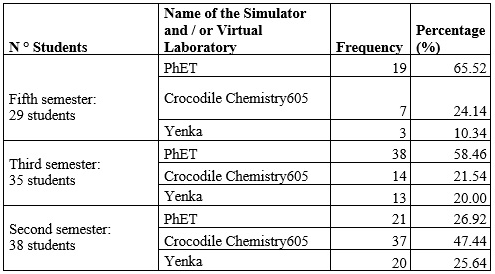
Source: Own elaboration from the registered data of the corresponding survey
Most fifth and third semester students show a relevant interest in PhET, because it is available for free on Web 2.0, easy to access, is in Spanish and can be used without a permanent internet connection after downloading. “
” (Villa 2020:25). The results of the simulation allow observing the phenomena at the micro and macro level in the experimentation; therefore, instant feedback is possible in a group and / or individual way if the case is required.The simulations are very striking; they even propose real-life cases to demonstrate the applicability of the content discussed
ANALYSIS OF THE ACADEMIC PERFORMANCE OF STUDENTS BY SEMESTERS
The qualifications of 102 students are available, the same that were obtained after having applied the experimental activities through three virtual resources: PhET, Crocodile Chemistry605 and Yenka, we are interested in evaluating the effectiveness of these three virtual simulators in the learning process of Chemistry.
For this, three virtual laboratory practices were applied using the aforementioned software in the second, third and fifth semester, as shown in Table 4 , the average obtained in the fifth semester was 6.97, likewise in the third semester the average corresponds to a value 7.07 and finally in the second semester the mean corresponds to 7.06, which indicates that there is no significant difference between the means; this is corroborated with the hypothesis test described in subsequent paragraphs.
ANALYSIS OF ACADEMIC PERFORMANCE BY SIMULATOR
The Figure 1 shows the academic performance of the students that were obtained after the application of virtual practices with the three virtual simulators: PhET, Crocodile Chemistry605 and Yenka, the scores were grouped according to the scale of qualifications described in table 1.
It is observed that students achieve the required learning using the three virtual simulators: PhET (52%), Crocodile Chemistry605 (60%) and Yenka (47%). And only 14% master the required learning using the virtual PhET simulator.
Next, a descriptive analysis of the academic performance variable against virtual simulators is presented: PhET, Crocodile Chemistry605 and Yenka, the same ones that were generated in the free access software Python.
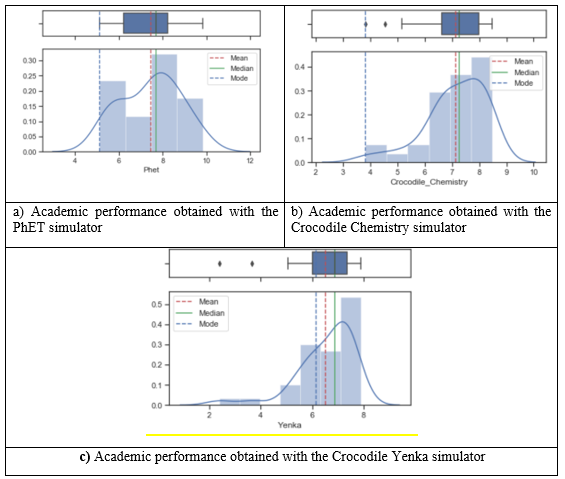
Source: own elaboration carried out in Python software
Figure 2: Box Plots and Distribution of Academic Performance Scores
Figure 2a represents the box plot and the distribution of the scores for the academic performance variable using the PHET simulator, the values of the mean (7.45), median (7.70) and mode (5.12) do not coincide, so the distribution of the data is skewed and skewed to the left, this shows that the data do not come from a normal distribution. The lowest score corresponds to a value of 5.12 and the highest score corresponds to a value of 9.83. The concentration of the data is between scores 7.8 and 8.5. The 50% of the students have obtained scores between 6.2 and 8.2.
Figure 2b provides a quick view of the data distribution of the academic performance variable using the Crocodile Chemistry simulator; it is asymmetric and skewed to the left, in the box plot it is observed that the median is not in the center of the box. The mean values (7.13), median (7.27) and mode (3.83) do not coincide so it is concluded that the data do not come from a normal distribution, this information will be very useful for the selection of the hypothesis test.
The lowest score is 3.8 and the highest score corresponds to a value of 8.5, with typical values. The whisker on the right (Xmax, Q4) is shorter than the one on the left; therefore 25% of the scores are more concentrated between 7.9 and 8.5. Likewise, 50% of the students have obtained scores between 6.7 and 8.
Figure 2c, corresponds to the box diagram about the Yenka simulator, provides a quick view of the distribution of the data, in this case, it is asymmetric and skewed to the left, the median is not in the center of the box. In addition, the values of the mean (6.53), median (6.87), and mode (6.15) do not coincide, so it is concluded that the data do not come from a normal distribution. The lowest score is 2.4 and the highest score corresponds to a value of 7.9, with typical values. The concentration of the data is within the 7.2 and 7.9 scores. Likewise, 50% of the students have obtained scores between 6 and 7.4
As we know, statistical studies allow us to make inferences about a characteristic of a population from the information contained in a sample. Next, the hypothesis test is carried out, the objective in the hypothesis testing process is to contrast the null hypothesis that the medians are equal, against the alternative hypothesis, for this, the following hypotheses are proposed:
To check whether there are statistically significant differences between the scores of the three simulators, it was important to the first establish whether the scores were normally distributed. Because of this assumption, the scores obtained were passed through the R studio to check whether the data were normally distributed.
With a significance level of 5% or α = 0.05, and under the following criteria, the normality of the data is previously carried out both visually and the normality test of the residuals using the Shapiro Wilk test as it is applicable to smaller samples. of 50,
P-value ≤ α: The differences between some of the medians are statistically significant.
P-value > α: The differences between the medians are not statistically significant.
Figure 3 was prepared in the free access statistical software R studio, and corresponds to the assumption of normality, being one of the most common for many statistical procedures, which allows us to verify if these assumptions are met and thus increase the reliability of the conclusions.
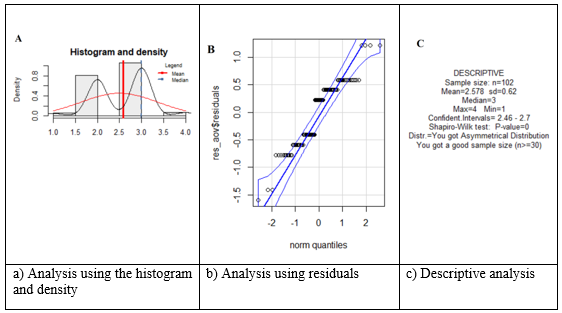
Source: Own elaboration carried out in the R-studio software
Figure 3: Normality test, elaborated in the statistical software R studio
From figure 3a) the histogram does not form a bell curve, which indicates that the residuals do not follow a normal distribution. 3b) the points in the QQ graphs do not follow the straight line and some data are outside the confidence bands, indicating that the residuals do not follow a normal distribution. 3c) Likewise, in the descriptive statistics, it indicates that there is an asymmetric distribution, which is visually verified that the data do not come from a normal distribution.
On the other hand, the normality of the data is demonstrated using the Shapiro-Wilk test because the sample is less than 50. The null and alternative hypothesis is:
Ho: the data come from a normal distribution
H1: the data do not come from a normal distribution
Next, the normality of the residuals is demonstrated with the Shapiro-Wilk test using the R studio software.

Source: own elaboration carried out in the free software R-studio
Figure 4: Shapiro Wilk test obtained in R studio
The p-value = 5.957e-06 of the Shapiro-Wilk test in the residuals is less than the usual significance level of α = 0.05, so the null hypothesis is rejected, and the alternative hypothesis is accepted, that is, the residuals do not follow a normal distribution. This result is in line with the visual approach. In our case, the assumption of normality is not fulfilled both visually and formally.
In the same way, with the help of the statistical software Rstudio, a comparison is made between the three simulators, thus the hypothesis test with Kruskall Wallis is also visually verified.
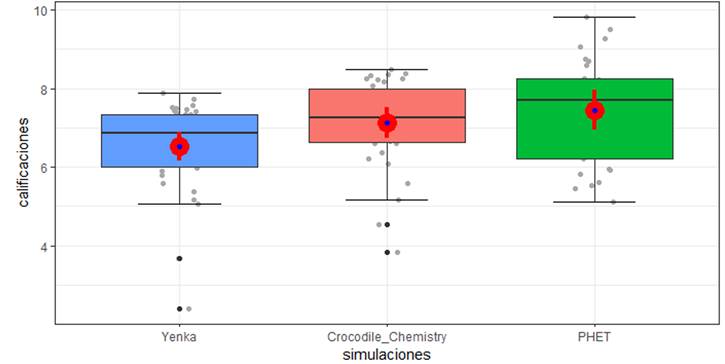
Source: Own elaboration carried out in the free software R-studio
Figure 5: Comparison of the three simulators, prepared in the R studio software
From Figure 5, the gray points represent the sample data, the black point represents the outlier, the blue point represents the mean, and the red point represents the 95% confidence interval.
In the PhET simulator, there is a greater dispersion of the data, which means that the data is further away from the mean; this is observed through the gray points.
The hypothesis is checked visually, the confidence intervals (red color) in the box plots overlap each other, which means that there is no strong statistical evidence that the medians are different. ExistsOutliers (black dot), in the Yenka and Crocodile Chemistry605 box plot these affect the values of the mean, median and other percentiles.
For this study and to answer the research question: Is there a significant difference in the academic performance of the students between the three simulators: PhET, Crocodile Chemistry605 and Yenka? The results of the Kruskall Wallis test revealed that there is no statistically significant difference between the scores obtained in the three simulators, indicating that any of the simulators could be used and an improvement in chemistry learning would be achieved.
The academic performance of 102 students was analyzed, 29 students used the PhET simulator, 35 students used the Crocodile Chemistry605 simulator, and 38 students used the Yenka simulator.
In Figure 6, the Kruskall Wallis test is graphically observed, it was made by using the free statistical analysis package Statdisk, the value of the H statistic is 3.57504, the theoretical value 5.99147 and finally the p-value is 0.16737. As the p-value is greater than the level of significance 0.05, the differences between the medians are not statistically significant, so the data do not provide enough evidence to indicate that there is a learning difference between the three simulators PhET, Crocodile Chemistry605 and Yenka.
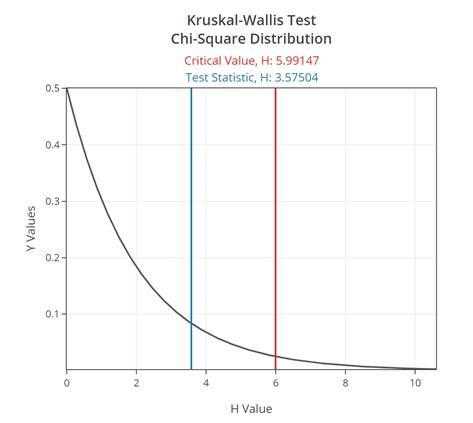
Source: Own elaboration carried out in the free software R-studio
Figure 6: Kruskal-Wallis hypothesis test
As seen in the Figure 6, the test statistic H = 3.57504 is not in the critical region limited by 5.991, so the null hypothesis that the population medians are equal is not rejected. In conclusion, there are no learning differences between the PhET, Crocodile Chemistry605 and Yenka simulators. As can be seen in the results, the use of experimental guides using simulators It allowed the student to provide frequent and interactive feedback on their learning. Becoming an important pedagogical resource that encourages collaborative work with close and distant colleagues; giving the opportunity to learn inside the classroom in synchronous time as well as outside of it in asynchronous time.
Among the digital tools designed for educational purposes, their visual impact and animation characteristics stand out, which can simulate the environment of real laboratories. The survey data verify that a large percentage of students fully agree and agree on considering the use of virtual simulators necessary, especially in times of a COVID-19 pandemic. “Currently, virtual learning environments can be used for e-learning, for distance learning, software applications or online games, through which constructive environments are created in Experimental Sciences” (Reyes, Reyes & Pérez 2016:22).
Students fully agree and agree to use the experimental guides making use of simulators and / or virtual laboratories to achieve learning results that allow the linking of theory with practice that contribute to meaningful learning.
The results show that the activities carried out motivate students to inquire about the contents covered in class, stimulate their participation in the development of activities, but above all contribute to the interpretation of conceptual and procedural contents of the subjects developed in the area of Chemistry.
Crocodile Chemistry605 and Yenka are programs that must be previously installed and are in the English language, which for some students made their use difficult. But they are virtual laboratories that give the student freedom to carry out experimental activities both those planned and also those that need to be carried out considering the universal chemical language. “
” (Villa 2020:25).There is a large amount of laboratory material and equipment, allowing the design and combination of simulation kits and even obtaining graphics in real time
From the constructivist conception of learning, and in contrast to mechanical or rote learning, it is assumed that meaningful learning is, in itself, motivating because the student enjoys doing the task or working, with these new contents; understands what has been done and gives meaning and application to what has been learned, giving rise to an intrinsic motivation, emerging a variety of satisfactory positive emotions, that favor learning, for this reason, “
” (Arias, Sandia & Mora 2012:22).the use of interactive technological tools as a support for teaching has generated demands for strategies that facilitate and guide their use in interactive distance education
On the other hand, some researchers in science teaching recognize and counteract the effectiveness of virtual learning in the sense that students do not always connect with the authenticity of virtual laboratory spaces (Hsu, Lin, & Yang 2017; Wu et al., 2013). Payne (2005) also reported that 53% of students participating in a high school study did not pass eLearning at all. Other recorded disadvantages of virtual learning included lack of technological knowledge, loss of realism, and more immersion in a virtual environment. (Penn & Ramnarain 2019:90)
Learning with a specialized guide is “more effective than that obtained by discovery with a minimal guide” (Kirschner, Sweller & Clark 2006:75) where each activity leads to “promote a more active, participatory and individualized teaching, where the scientific method and critical spirit are promoted, developing elementary skills and techniques in the students” (Chasi 2017:11).
Before starting a laboratory practice with simulators, it is necessary to plan the pedagogical strategy; keep in mind a schedule with the sequence of topics prior to using the simulator, and establish objectives, abilities, skills and capabilities that was wanted to develop in the student. These recommendations have been proposed by various authors (Reyes, Reyes & Pérez 2016).
As it has been shown that the data do not come from a normal distribution, the non-parametric Kruskall Wallis test is selected; this test is used to understand if academic performance differs between the three types of virtual simulators, (that is, its dependent variable “academic performance” and its independent variable “virtual simulators for learning chemistry in times of pandemic”, with three independent groups: PhET, Crocodile Chemistry605 and Yenka simulators).
In this new era in education it is important, that as teachers, we use innovative and different didactic strategies in the classroom, a good option is the use of ICTs, which allow us to “capture the interest of students in topics they consider difficult, boring and without practical cases in media that they know and master perfectly, such as the use of computer and technological tools” (Rodríguez, Obaya & Vargas 2021:63).
The application of experimental guides using simulators and virtual laboratories “produce positive effects on students, with favorable consequences for the teaching of Chemistry contents that are considered problematic topics by students due to their level of abstraction” (Ayón & Victores 2020:15), which makes them stay motivated during the application process leading to significant learning.
The results showed that the simulation works in a similar way to the experimental method, “despite operating at different cognitive levels. Simulation work is considered particularly important to promote self-directed learning” (Zendler & Greiner 2020:10).
CONCLUSIONS
Regarding the perceptions of the students of the Pedagogy in Biology and Chemistry career about the usefulness of the PhET, Crocodile Chemistry605 and Yenka simulations for learning chemistry, it was carried out, on the basis of two aspects: cognitive and procedural, evidencing that more than 50% fully agree that the virtual simulators described above, are useful both for a better understanding of chemical phenomena, and a better connection between mathematical knowledge and an understanding of chemistry, contributing to their academic training in times of Pandemic caused by COVID-19.
Likewise, the construction of the didactic sequence with the use of simulators was based on Ausubel's theory of significant learning and helped to understand the teaching-learning processes involving three pedagogical moments: initial problematization, organization of knowledge, and application of knowledge.
In response to the research question, is there any significant difference in the academic performance of the students using the three virtual simulators: Phet, Crocodile Chemistry605 and Yenka? It is shown that there is no difference in the academic performance of the students when using the three virtual simulators such as: PhET, Crocodile Chemistry605 and Yenka, this was corroborated by the Kruskall Wallis test, as demonstrated in previous paragraphs.
The use of the PhET simulator and virtual laboratories: Crocodile Chemistry605 and Yenka allowed feedback and motivation during the development of each experimental activity.
In conclusion, the simulators and virtual laboratories PhET, Crocodile Chemistry605 and Yenka generated interest in the second, third and fifth semester students, because they consider a versatile tool that allows the content to be feedback both synchronously and asynchronously. In addition, the use of the PhET simulator, due to the facilities that the tool provides, such as access to it without an internet connection once downloaded, facilitates its use by virtue of the fact that the language is in Spanish















